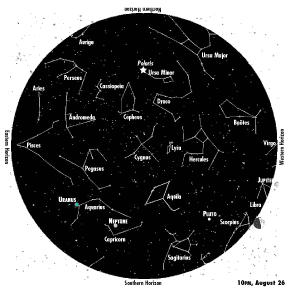 |
Sky Watch
by J. Alex Knoll
|
Celestial Sights for Waning Summer Nights
Moon slivers, elusive planets and heroes
The new waxing moon is still too fresh at week’s end and doesn’t offer even an appearance until Saturday, when keen eyes and good timing may reward you with a view of the thin sliver above the western horizon in the 15 minutes following sunset at 7:45. Subsequent evenings present easier sightings as the moon appears a little higher with darkness and sets about 20 minutes later each night.
Tuesday, the moon travels westward accompanied by Jupiter, last of the planets visible to the unaided eye in the evening. The two are a little more than five degrees apart, easily within the field of view of a pair of binoculars, and they arch up from the southwest horizon before setting around 9pm.
At the other side of darkness, Saturn and Venus break the hold of the sun, cresting the northeast horizon at 4am Sunday morning and separated by just a fraction of a degree. Within an hour the pre-dawn haze begins to bleach out the planets, which have climbed at best 15 degrees above the horizon.
In the waning days of summer, the constellation Perseus rises into view, coinciding with the annual Perseid meteor shower, which was washed out by moonlight this year. One of three great Greek heroes in the sky, Perseus stands apart and above his peers Orion and Hercules.
Orion, the most handsome man and the greatest hunter, was wild and reckless, ravaging women during his exploits and killed in the end for his vanity. Hercules, too, received his 12 labors as punishment for killing his own children in a maddened rage. Perseus bore no such baggage.
He was conceived when Zeus visited the maiden Danae as a shower of golden rain, a scene played out each year at this time by the meteors that bare his name.